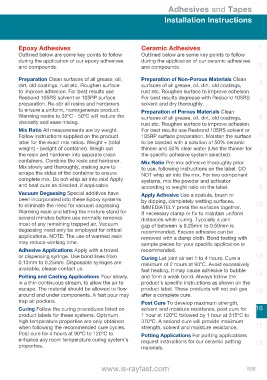Page 507 - IS-Rayfast Catalogue - Issue 9, 2017
P. 507
Adhesives and Tapes
Installation Instructions
Epoxy Adhesives Ceramic Adhesives 1
Outlined below are some key points to follow Outlined below are some key points to follow
during the application of our epoxy adhesives during the application of our ceramic adhesives
and compounds. and compounds. 2
Preparation Clean surfaces of all grease, oil, Preparation of Non-Porous Materials Clean
dirt, old coatings, rust etc. Roughen surface surfaces of all grease, oil, dirt, old coatings, 3
to improve adhesion. For best results use rust etc. Roughen surface to improve adhesion.
Resbond 105RS solvent or 105RP surface For best results degrease with Resbond 105RS 4
preparation. Re-stir all resins and hardeners solvent and dry thoroughly.
to ensure a uniform, homogeneous product. Preparation of Porous Materials Clean
Warming resins to 35ºC - 50ºC will reduce the
surfaces of all grease, oil, dirt, old coatings, 5
viscosity and ease mixing. rust etc. Roughen surface to improve adhesion.
Mix Ratio All measurements are by weight. For best results use Resbond 105RS solvent or
Follow instructions supplied on the product 105RP surface preparation. Moisten the surface 6
label for the exact mix ratios. Weight = (total to be bonded with a solution of 50% ceramic
weight) - (weight of container). Weigh out thinner and 50% clear water (Use the thinner for
the resin and hardener into separate clean the specific adhesive system selected). 7
containers. Combine the resin and hardener.
Mix Ratio Pre-mix adhesive thoroughly prior
Mix slowly and thoroughly, making sure to to use, following instructions on the label. DO 8
scrape the sides of the container to ensure NOT whip air into the mix. For two component
complete mix. Do not whip air into mix! Apply
systems, mix the powder and activator
and heat cure as directed, if applicable. according to weight ratio on the label. 9
Vacuum Degassing Special additives have
Apply Adhesive Use a spatula, brush or
been incorporated into these Epoxy systems by dipping, completely wetting surfaces,
to eliminate the need for vacuum degassing. 10
IMMEDIATELY press the surfaces together.
Warming resin and letting the mixture stand for If necessary clamp or fix to maintain uniform
several minutes before use normally removes distances while curing. Typically a joint
most of any remaining trapped air. Vacuum 11
gap of between is 0.25mm to 0.50mm is
degassing need only be employed for critical recommended. Excess adhesive can be
applications. NOTE: The use of warmed resin
removed with a damp cloth. Bond testing with 12
may reduce working time. sample pieces for your specific application is
Adhesive Applications Apply with a trowel recommended.
or dispensing syringe. Use bond lines from Curing Let joint air set 1 to 4 hours. Cure a 13
0.13mm to 0.25mm. Disposable syringes are minimum of 2 hours at 90ºC. Avoid excessively
available, please contact us.
fast heating. It may cause adhesive to bubble
Potting and Casting Applications Pour slowly, and form a weak bond. Always follow the 14
in a thin continuous stream, to allow the air to product’s specific instructions as shown on the
escape. The material should be allowed to flow product label. These products will not out-gas 15
around and under components. A fast pour may after a complete cure.
trap air pockets. Post Cure To develop maximum strength,
Curing Follow the curing procedures listed on solvent and moisture resistance, post cure for 16
product labels for these systems. Optimum 1 hour at 120ºC followed by 1 hour at 315ºC to
high temperature properties are only obtained 370ºC. A second cure will provide maximum
when following the recommended cure cycles. strength, solvent and moisture resistance. 17
Post cure for 4 hours at 90ºC to 120ºC to Potting Applications For potting applications
enhance any room temperature curing system’s request instructions for our ceramic potting
properties. materials. 18
www.is-rayfast.com 505

